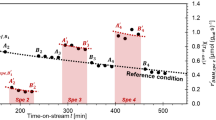Abstract
The relation between heats of dissociation leading to the formation of lower oxide phases (q) and heats of dissociation without change in the oxide phase (qS) is analyzed. In the majority of cases qS is close to q; however, in the case of the higher oxides of V, Mo, W, and U, the difference qS-q is large. This leads to the systematic elimination of these oxides from the relationship correlating catalytic activity and q. The possibility is considered of using a kinetic characteristic (for example, reducibility) in evaluating the stability of the bond of the surface oxygen in oxides.
The principal limitation to the application of the thermodynamic method of predicting the catalytic activity of substances is formulated. This is the fact that it is useful only for evaluating the relative activity in a series of monotypic catalysts for the same reaction. The transition metals and oxides are established as not being monotypic catalysts for the oxidation of hydrogen.
Similar content being viewed by others
References
G. I. Golodets and V. A. Roiter, Ukr. khim. zhurn., 29, 667, 1963.
V. A. Roiter and G. I. Golodets, Problems in Kinetics and Catalysis, XI (The Scientific Basis of Catalyst Selection) [in Russian], Nauka, Moscow, p. 56, 1966.
G. K. Boreskov, Problems in Kinetics and Catalysis, XI (The Scientific Basis of Catalyst Selection) [in Russian], Nauka, Moscow, p. 45, 1966.
V. I. Vedeneev, L. V. Gurvich, V. N. Kondrat'ev, V. A. Medvedev, and E. L. Frankevich, Dissociation Energies of Chemical Bonds, Ionization Potentials, and Electron Affinities [in Russian], Izd-vo AN SSSR, Moscow, 1962.
Ya. I. Gerasimov et al., Chemical Thermodynamics and Nonferrous Metallurgy [in Russian], Izd-vo tallurgizdat, Moscow, vol. 2, 1961.
Handbook of Chemistry and Physics, ed. C. D. Hodgman, Chemical Rubber Publ. Co., Cleveland, Ohio, p. 526, 1961.
Concise Chemical Encyclopedia [in Russian], vols. I–IV, Sovetskaya entsiklopediya, Moscow, 1961–1965.
A. N. Zelikman, G. V. Samsonov, and O. E. Krein, Metallurgy of the Rare Elements [in Russian], Metallurgizdat, Moscow, 1964.
N. V. Kul'kova and M. I. Temkin, ZhFKh, 31, 2017, 1957.
F. D. Rossini et al., Selected Values of Chemical Thermodynamic Properties, Circ. Nat. Bur. Stand., p. 500, 1952.
M. Kh. Karapet'yants and M. L. Karapet'yants, “Tables of some thermodynamic properties of various substances,” Tr. MKhTI im D.I. Mendeleeva, Moscow, no. 34, 1961.
V. E. Ostrovskii and N. N. Dobrovol'skii, DAN SSSR, 172, 649, 1967.
S. L. Kiperman, Izv. AN SSSR OKhN, 1129, 1957.
N. V. Kul'kova and M. I. Temkin, ZhFKh, 36, 1731, 1962.
G. De Maria, R. P. Burns, J. Drowart, and M. G. Inghram, J. Chem. Phys., 32, 1373, 1960.
A. V. Gershingorina, V. M. Belousov, M. Ya. Rubanik, and Zh. F. Buteiko, collection: Catalysis and Catalysts [in Russian], vol. 3, Naukova Dumka, Kiev, p. 36, 1967.
G. I. Golodets, TEKh [Theoretical and Experimental Chemistry], 1, 755, 1965.
W. M. H. Sachtler and N. H. de Boer, Proc. 3-rd Internat. Congress on Catalysis, North-Holland Publ. Co., Amsterdam, vol. 1, p. 252, 1965.
A. N. Kuznetsov. The Physicochemical Basis of Pig Iron Production [in Russian], Metallurgizdat, Moscow, p. 80, 1956.
F. Glaser, Z. anorg. Chem., 36, 1, 1903.
G. K. Boreskov, Adv. in Catalysis, 15, 285, 1964.
V. A. Komarov, ZhFKh, 27, 1748, 1953.
N. I. Il'chenko and V. A. Yuza, collection: Catalysis and Catalysts [in Russian], Naukova Dumka, Kiev, vol. 2, p. 118, 1966.
A. A. Balandin, The Multiplet Theory of Catalysis [in Russian], Izd-vo. MGU, Moscow, pt. 2, 1964.
M. I. Temkin, ZhFKh, 31, 3, 1957.
S. L. Kiperman, Introduction to the Kinetics of Heterogeneous Catalytic Reactions [in Russian], Nauka, Moscow, 1964.
G. I. Golodets, collection: Catalysis and Catalysts [in Russian], Naukova Dumka, Kiev, vol. 2, p. 25, 1966.
V. V. Popovskii and G. K. Boreskov, Problemy kinetiki i kataliza, 10, 67, 1960.
V. V. Popovskii, G. K. Boreskov, and V. S. Muzykantov, ZhFKh, 35, 192, 1961.
E. N. Khar'kovskaya, G. K. Boreskov, and M. G. Slin'ko, DAN SSSR, 127, 145, 1959.
G. K. Boreskov, M. G. Slin'ko, A. G. Filippova, and R. N. Gur'yanova, DAN SSSR, 94, 713, 1954; G. K. Boreskov, ZhFKh, 31, 937, 1957.
A. Clark, Ind. Engng. Chem., 45, 1476, 1953.
Author information
Authors and Affiliations
Rights and permissions
About this article
Cite this article
Golodets, G.I., Pyatnitskii, Y.I. & Goncharuk, V.V. On thermodynamic and kinetic characteristics applicable in evaluating the relative catalytic activity of oxides. Theor Exp Chem 4, 31–35 (1970). https://doi.org/10.1007/BF00525943
Issue Date:
DOI: https://doi.org/10.1007/BF00525943




